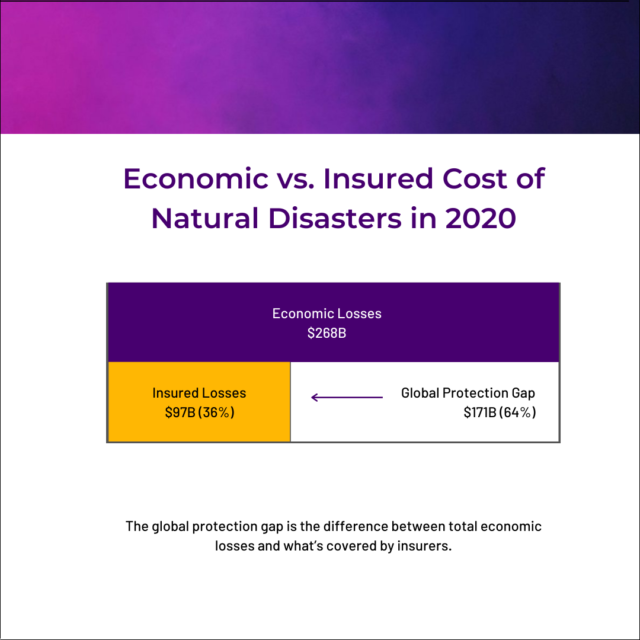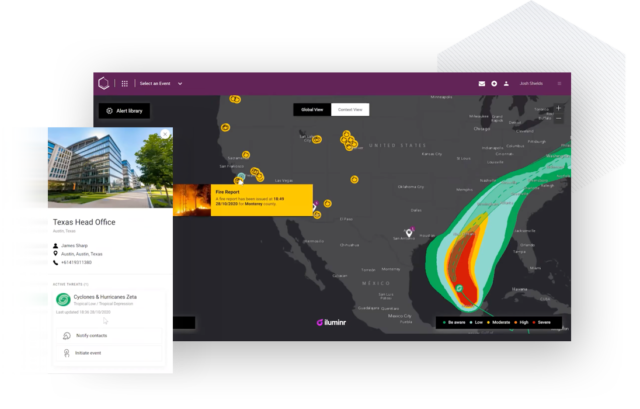As the frequency and impact of natural disasters continue to grow, the need to both mitigate and adapt to the effects of climate change has become undeniable. Rated the Top 4 of 5 Likely Risks to impact organizations worldwide in 2021, environmental threats and climate risk are being reprioritized as both a potential threat and responsibility to be better managed in most Western societies.
Costing an estimated $268b in economic losses in 2020, Aon reports that the insurance losses experienced from natural disaster events were $97b. Leading to an insurance protection gap of $171b, many organizations would be hard-pressed to weather the financial impacts of climate-related events.
As the world strategizes to move toward a carbon neutral economy, governments and organizations must contend with managing the short and long-term impacts of climate change and physical climate risks.
What Are Physical Climate Risks?
The United Nations defines climate-related risks to be hazards resulting from environmental events, including:

Physical risks (extreme weather events)
Transitory risks (required changes to policy, practice, or profitability)
Liability risks (the responsibility that may be placed on an organization by future generations affected by climate change)
Physical climate risks are the effects of environmental events that can affect tangible organizational assets including offices, warehouses, transportation and supply chain capabilities, equipment, and people.
Knowing that an organization faces physical threats (to people and places), risk professionals should assess and contextualize both tangible and intangible environmental events. By undertaking a climate risk assessment, the process of analyzing internal and external organizational environments can help teams better prepare for physical climate risks.
Why Do Physical Climate Risks Continue to Escalate in Priority?
As the impacts of extreme weather events continue to escalate, the economic losses associated with physical climate risks continue to grow. “Unprecedented” continues to trend when reporting on bushfires, hurricanes, and flash flooding events with few expectations of dying out in popularity any time soon.
 Following an announcement declaring their intent to join the International Coalition for Climate Resilient Investment (CCRI) in 2021, Australia is expected to join 75 global institutional investors, banks, insurers, and rating and government agencies committed to building more climate resilient economies. With the Biden Administration quickly recommitting to the UNFCCC Paris Agreement in January 2021, the international effort to combat the effects of climate change are expected to be reprioritized—even while many countries continue to actively battle COVID-19.
Following an announcement declaring their intent to join the International Coalition for Climate Resilient Investment (CCRI) in 2021, Australia is expected to join 75 global institutional investors, banks, insurers, and rating and government agencies committed to building more climate resilient economies. With the Biden Administration quickly recommitting to the UNFCCC Paris Agreement in January 2021, the international effort to combat the effects of climate change are expected to be reprioritized—even while many countries continue to actively battle COVID-19.
Now with increased expectations from investors, regulators, and consumers to show evidence of actions taken to minimize the impact of weather-related events, risk managers worldwide need to analyze, strategize, and adopt the toolsets needed to better manage physical climate risks.
How To Manage Evolving Physical Climate Risks
As climate change continues to unleash “unprecedented” events, it’s critical that organization’s consider new ways to combat the increased impacts from physical climate risks. The following are several key steps to consider when proactively planning to better manage your organization’s physical climate risks.
1. Identify Potential Exposures
The first step to better managing climate-related risks is understanding where your exposures sit and how exposed your asset locations might be to changing threat models. Although mapping key organizational locations is critical, it is also important to acknowledge that existing site exposure data may be based on historical events and may not consider evolving environmental changes.
With the frequency and effects of weather-related events continually increasing, insurance companies and organizations such as Risk Frontiers that specialize in exposure assessment can help your team more accurately model for evolving climate threats at both primary and secondary sites. Much the same as reviewing historical exposure data, Risk Managers should be wary of assuming that past climate-related events will continue to unfold in the same pattern, or that critical suppliers will continue to respond in the same manner.
2. Analyze the Organizational Impacts of Climate Risk
To best minimize the impact of a physical climate-related threat against one of your primary or secondary locations, consider the unique qualities of each of your major organizational units and detail the potential impacts and a response plan for:
People – personnel safety and well-being both immediate and ongoing
Operations – potential operational disruptions from threats such as fire, flood, or tropical storm
Regulatory – consider if the impacts of a major site-based climate-related event could create a breach in regulation considering environmental impacts, health and safety, and more
Physical assets – consider if the assets located in potential exposure areas were constructed or stored with the intent of sustaining a major physical threat. Further, explore what the flow-on effects of a loss of key site or asset could be. (For example, critical equipment or whole-site destruction.)
Taking the time to work through the exposures and potential impacts of your organization’s primary and secondary site locations can help your team both better prepare for potential events and respond with speed if they do. Understanding and articulating these exposures may also help communicate the importance of undertaking risk management activities including operational response and pre-event capital expenditure.
3. Bring Agility to Critical Event Strategies
Critical to the success of navigating continuously evolving climate-related threats is considering the resources and communication strategies that might be needed during an unfamiliar event. With organizational agility kept at the top of mind, both group and site level strategies should be prepared accepting that each type of critical event and asset location will require a flexible and unique response. To get started, consider the following:
Getting ahead of events: What lead indicators will give you a head start on responding to an emerging threat? A good example of a key indicator would be an early warning severe weather alert system, set up for assets located in a flood prone area. Platforms like iluminr, are an accessible, modern solution that uses real-time data to monitor threats, and can automate alerts to key decision makers about an escalating weather-related event. 
Champions who lead: Have you identified champions at both site and group levels to be alerted when a lead indicator is triggered? Do these champions understand their key touchpoints and communication tools to be used to create an effective network for event management? By working with champions throughout the organization, you can build threat awareness and establish a communication network that will eventually become the freeway of event intelligence when a situation unfolds.
Replicable first steps: In preparation for an impending threat, every minute from every team member counts. To capitalize on the finite time available during an escalating critical event, it is crucial for site-based champions and teams to understand their first response actions. On receipt of an early warning notification, immediate first response steps should include analyzing the incident and considering the most likely, and most affecting, impacts. The tools, resources, and intelligence needed to address these impacts should assist in formulating event-based response and mitigation strategies.
Prepared and accessible checklists and playbooks can offer guidance and simplify this process when conditions are deteriorating. To make the resources effective, each guide should be succinct, communicable, easily accessed both on and off-site, and relevant to the team. Instead of unintentionally creating a singular point of failure by relying on one key team member to support the whole team, an accessible playbook that is easy to follow can help all team members navigate to success.
Build a multi-disciplinary response team: Each critical event will unfold differently. Because of this, teams must have the confidence to adapt their response based on the unique threat and resources at hand. An effective response team taps into the unique skills and capabilities of their members, including communications, technical expertise, and networking. Strong communicators may be the best to head up project management while technical experts can help navigate health and safety needs, and networkers can stay connected with and inform their community.
Establish a common operating picture: Whether your response team is metres apart or located in a different country, establishing a common operating picture ensures that good decisions can be made based on fact and align with strategic priorities. To ensure all team members are kept informed and up-to-date, all parties should have access to an event room that prioritizes real time connectivity, the ability to categorize data (fact, assumption, issue, task), and a simple way to record and store intelligence.
Critical event management systems, like CQ, leverage dedicated online event rooms to keep everyone connected and organized during an escalating event. Instead of relying solely on everyday communication channels like MS Teams or WhatsApp—which could result in insufficient evidence of actions taken—a digitalized critical event platform can keep all team members informed.
4. Increase Organizational Capabilities by Exercising Microsimulations
Building a culture of critical event awareness and response capability is critical to mitigating the effects of physical climate risks. Working through unprecedented scenarios with organizational stakeholders can help your team identify the critical success factors needed to prepare for, navigate, and recover from a climate-related event. 
Microsimulations and larger traditional scenario exercises can assist in identifying and refining both pre-event risk management activities and response strategies. Historically limited to executive and senior-level management teams, site-based personnel have been left without practice and an understanding of how to best respond to critical events. To overcome this barrier, organizations can adopt a digital critical event management platform to conduct frequent, inexpensive micro-simulation exercises that can build team resilience.
Examples of micro-simulation testing objectives could include:
1. Create awareness and familiarity with a site-based critical event response plan
2. Test the speed with which site-based teams can escalate an event to a remote critical event management team the time and connectivity of incident escalation between site and group of a severe flood warning
3. Identify critical functions that might be impacted by a prolonged power outage caused by a severe weather event
Not to take away from the importance of annual crisis simulation exercises, frequent, ongoing simulations can enhance team critical event capability and awareness at a whole organizational level. By enacting crisis workflows and action plans during business-as-usual periods, teams can familiarize with the critical event management and communication platforms to be relied on during a challenging event.
If you’re looking to better manage and mitigate the potential impacts of climate-related risks for your organization, speak to the Catalyst Technologies team about levelling up to a digital threat monitoring and response system. With an integrated platform to support crisis intelligence feeds, mass communications, and centralized intelligence, digital tools like CQ and iluminr can help you prepare for an escalating rate of climate risks and keep your team safe today.
—
References
- Investor Daily
- UN (United Nations)
- World Economic Forum
- Bank of England/PRA
- Aon
- Natural Resources Defense Council, 2021













